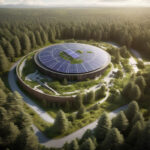Quantum-inspired Tech Reveals Plasma Turbulence Secrets for Nuclear Fusion Reactors
Physicists in Japan have drawn inspiration from mathematical frameworks in quantum mechanics such as information theory and quantum entanglement to unlock the secrets of plasma turbulence in nuclear fusion reactors. This groundbreaking approach marries the complexities of quantum mechanics with the challenging dynamics of plasma turbulence, offering a promising avenue for overcoming one of the biggest hurdles in achieving sustainable nuclear fusion energy.
The quest for nuclear fusion as a clean, abundant, and virtually limitless energy source has long been hindered by the unruly behavior of plasma within reactors. Plasma turbulence, characterized by chaotic and unpredictable fluctuations in temperature, density, and magnetic fields, poses a significant obstacle to maintaining the stable conditions required for controlled fusion reactions. By harnessing quantum-inspired techniques, researchers have made strides in understanding and, ultimately, mitigating the adverse effects of turbulence on fusion energy production.
At the heart of this innovative approach lies the concept of quantum entanglement, a phenomenon where particles become interconnected and their states are correlated regardless of the distance between them. By applying principles of entanglement to the analysis of plasma turbulence, physicists have been able to discern underlying patterns and relationships that were previously obscured by the chaotic nature of the system. This newfound clarity has paved the way for more effective control strategies to suppress turbulence and optimize fusion reactions.
Moreover, insights from information theory, a branch of quantum mechanics concerned with the transmission and processing of information, have proven instrumental in decoding the intricate interplay of variables driving plasma turbulence. By treating turbulence as a dynamic system of information exchange, researchers have been able to develop sophisticated algorithms and computational models to predict and manage turbulence-induced instabilities within fusion reactors. This holistic approach not only enhances our fundamental understanding of plasma behavior but also offers practical solutions for enhancing the efficiency and reliability of future fusion power plants.
The implications of quantum-inspired tech in unraveling plasma turbulence secrets extend far beyond the realm of nuclear fusion. The synergy between quantum mechanics and plasma physics opens up new possibilities for tackling complex challenges in various fields, from astrophysics to materials science. By leveraging the principles of quantum entanglement, information theory, and other quantum-inspired tools, scientists can gain fresh perspectives on age-old problems and drive innovation in ways previously thought impossible.
As we stand on the cusp of a new era in energy production, fueled by the promise of nuclear fusion, the fusion community is increasingly turning to quantum-inspired technologies to surmount longstanding obstacles and usher in a sustainable future. The marriage of quantum mechanics and plasma physics holds immense potential for revolutionizing not only how we harness fusion energy but also how we approach scientific inquiry and technological advancement in the 21st century.
In conclusion, the integration of quantum-inspired tech into the study of plasma turbulence represents a paradigm shift in our quest for viable nuclear fusion energy. By tapping into the rich tapestry of quantum mechanics, researchers are decoding the enigmatic behaviors of plasma turbulence and paving the way for a new era of clean, safe, and abundant energy. With each breakthrough, we edge closer to realizing the long-awaited dream of fusion power and shaping a brighter tomorrow for generations to come.
#QuantumInspiredTech, #PlasmaTurbulence, #NuclearFusionReactors, #InnovationInEnergy, #SustainableFuture












